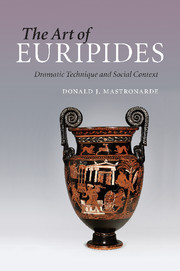Book contents
- Frontmatter
- Contents
- Preface
- Abbreviations and reference system
- 1 Approaching Euripides
- 2 Problems of genre
- 3 Dramatic structures: variety and unity
- 4 The chorus
- 5 The gods
- 6 Rhetoric and character
- 7 Women
- 8 Euripidean males and the limits of autonomy
- Conclusion
- Bibliography
- Index of names and topics
- Index of passages cited
7 - Women
Published online by Cambridge University Press: 04 May 2010
- Frontmatter
- Contents
- Preface
- Abbreviations and reference system
- 1 Approaching Euripides
- 2 Problems of genre
- 3 Dramatic structures: variety and unity
- 4 The chorus
- 5 The gods
- 6 Rhetoric and character
- 7 Women
- 8 Euripidean males and the limits of autonomy
- Conclusion
- Bibliography
- Index of names and topics
- Index of passages cited
Summary
In previous chapters, we have seen how various techniques and patterns related to structural strategies, the chorus, the gods, and rhetorical speeches serve to draw the audience of Euripidean drama into a dynamic process of inference and interpretation, frequently resulting in reversals of sympathy or destabilization of judgment, inviting exploration of routine assumptions and recognition of complexity and indeterminacy. The representations of women in Euripidean tragedy also contribute to this process in an important way. Women in tragedy have been a fruitful topic for research in recent decades because of the strong impetus toward greater equality of the sexes in Western societies as well as because of the significant shifts in the faculties and student bodies of academic institutions and in the critical theories prevalent in the humanities and social sciences. At the same time, this interest is not merely a sign of our own concerns in the late twentieth and early twenty-first century. Greek culture in general was frequently self-analytic and produced many normative statements on the roles of the sexes as well as on other matters of social and political organization. Euripidean plays in particular (both surviving and lost) contain a greater number of major female roles, they more frequently explore domestic and personal themes, and they show a pervasive engagement with contemporary intellectual trends, among which was the provocative analysis of nature and culture and the questioning of accepted norms, including those pertaining to gender.
- Type
- Chapter
- Information
- The Art of EuripidesDramatic Technique and Social Context, pp. 246 - 279Publisher: Cambridge University PressPrint publication year: 2010

